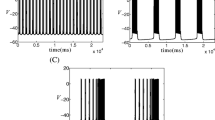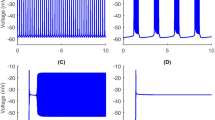Abstract
The respiratory rhythm is initiated and controlled by the respiratory center. The pre-Bötzinger complex is a key part of the origin of respiratory rhythms in mammals. The regulatory mechanism of the respiratory rhythm has been a prominent topic for researchers. By monitoring the changes in oxygen and carbon dioxide concentrations in the blood, it has been found that peripheral chemoreceptors can significantly influence the respiratory rhythm. In this study, using a closed-loop respiratory control model based on pre-Bötzinger complex neurons, by incorporating the motor pool, lung volume, lung oxygen, blood oxygen, and chemoreceptors, we investigate how the response of the system changes after the same hypoxic perturbation when the initial state of the neuron system is different types of mixed bursting patterns. The results show that the system can recover when the initial state consists of one or two somatic bursters and one dendritic burster. However, the system cannot recover when the initial state consists of three or four somatic bursters and one dendritic burster. Due to the complexity of calcium currents, we simulate the complex calcium current with a square wave current to achieve consistent hypoxic responses in the system. Subsequently, using bifurcation analysis and control theory, we investigate the dynamic mechanisms underlying the changes in the system after hypoxic perturbation. According to the bifurcation analysis, we show that different initial states lead to changes of the bifurcation structure of the system, which result in different responses after hypoxic perturbation. This study contributes to a better understanding of the interaction between the respiratory center and peripheral chemical sensory feedback and their influence on the respiratory rhythm.













Similar content being viewed by others
Data availability
Code and data for MATLAB and XPPAUT used to support this research are available upon reasonable request through the corresponding author.
References
Smith, J.C., Ellenberger, H.H., Ballanyi, K., et al.: Pre-Bötzinger complex: a brainstem region that may generate respiratory rhythm in mammals. Science 254(5032), 726–729 (1991)
Morris, K.F., Nuding, S.C., Segers, L.S., et al.: Carotid chemoreceptors tune breathing via multipath routing: reticular chain and loop operations supported by parallel spike train correlations. J. Neurophysiol. 119(2), 700–722 (2018)
Molkov, Y.I., Shevtsova, N.A., Park, C., et al.: A closed-loop model of the respiratory system: focus on hypercapnia and active expiration. PLoS ONE 9(10), e109894 (2017)
Pagliardini, S., Greer, J.J., Funk, G.D., et al.: State-dependent modulation of breathing in urethane-anesthetized rats. J. Neurosci. 32(33), 11259–11270 (2012)
Andrews, C.G., Pagliardini, S.: Expiratory activation of abdominal muscle is associated with improved respiratory stability and an increase in minute ventilation in REM epochs of adult rats. J. Appl. Physiol. 119(9), 968–974 (2015)
Diekman, C.O., Thomas, P.J., Wilson, C.G.: COVID-19 and silent hypoxemia in a minimal closed-loop model of the respiratory rhythm generator. BioRxiv (2023). https://doi.org/10.1101/2023.04.19.536507
Ben-Tal, A., Smith, J.C.: A model for control of breathing in mammals: coupling neural dynamics to peripheral gas exchange and transport. J. Theor. Biol. 251(3), 480–497 (2007)
Diekman, C.O., Thomas, P.J., Wilson, C.G.: Eupnea, tachypnea, and autoresuscitation in a closed-loop respiratory control model. J. Neurophysiol. 118(4), 2194–2215 (2017)
Diekman, C.O., Thomas, P.J., Wilson, C.G.: Experimental validation of a closed-loop respiratory control model using dynamic clamp. In: 2018 40th Annual International Conference of the IEEE Engineering in Medicine and Biology Society (EMBC), pp. 5273–5276. IEEE (2018)
Yu, Z.J., Thomas, P.J.: Dynamical consequences of sensory feedback in a half-center oscillator coupled to a simple motor system. Biol. Cybern. 115(2), 135–160 (2021)
Desroches, M., Kaper, T.J., Krupa, M.: Mixed-mode bursting oscillations: dynamics created by a slow passage through spike-adding canard explosion in a square-wave burster. Chaos 23(4), 046106 (2013)
Wang, Y.Y., Rubin, J.E.: Timescales and mechanisms of sigh-like bursting and spiking in models of rhythmic respiratory neurons. J. Math. Neurosci. 7, 3 (2017)
Duan, L.X., Liang, T.T., Zhao, Y.Q., et al.: Multi-time scale dynamics of mixed depolarization block bursting. Nonlinear Dyn. 103(1), 1043–1053 (2021)
Ji, W.C., Liu, M.T., Duan, L.X.: Influence of electric current and magnetic flow on firing patterns of pre-Bötzinger complex model. Neural Plast. (2021). https://doi.org/10.1155/2021/6655933
Dunmyre, J.R., Del Negro, C.A., Rubin, J.E.: Interactions of persistent sodium and calcium-activated nonspecific cationic currents yield dynamically distinct bursting regimes in a model of respiratory neurons. J. Comput. Neurosci. 31(2), 305–328 (2011)
Toporikova, N., Butera, R.J.: Two types of independent bursting mechanisms in inspirator neurons: an integrative model. J. Comput. Neurosci. 30(3), 515–528 (2011)
Park, C., Rubin, J.E.: Cooperation of intrinsic bursting and calcium oscillations underlying activity patterns of model pre-Bötzinger complex neurons. J. Comput. Neurosci. 34(2), 345–366 (2013)
Lü, Z.S., Liu, M.R., Duan, L.X.: Dynamical analysis of dendritic mixed bursting within the pre-Bötzinger complex. Nonlinear Dyn. 103(1), 897–912 (2021)
Ben-Tal, A., Tawhai, M.H.: Integrative approaches for modeling regulation and function of the respiratory system. WIREs Syst. Biol. Med. 5(6), 687–699 (2013)
Lindsey, B.G., Rybak, I.A., Smith, J.C.: Computational models and emergent properties of respiratory neural networks. Compr. Physiol. 2, 1619–1670 (2012)
Xia, Y.B., Zhang, Z.D., Bi, Q.S.: Relaxation oscillations and the mechanism in a periodically excited vector field with pitchfork-Hopf bifurcation. Nonlinear Dyn. 101, 37–51 (2020)
Liu, Z., Yu, Y., Wang, Q.: Functional modular organization unfolded by chimera-like dynamics in a large-scale brain network model. Sci. China Tech. Sci. 65(7), 1435–1444 (2022)
Liu, Z., Han, F., Wang, Q.: A review of computational models for gamma oscillation dynamics: from spiking neurons to neural masses. Nonlinear Dyn. 108(3), 1849–1866 (2022)
Golowasch, J.: Neuromodulation of central pattern generators and its role in the functional recovery of central pattern generator activity. J. Neurophysiol. 122(1), 300–315 (2019)
Del Negro, C.A., Funk, G.D., Feldman, J.L.: Breathing matters. Nat. Rev. Neurosci. 19(6), 351–367 (2018)
Prabhakar, N.R., Peng, Y.H., Kumar, G.K., et al.: Altered carotid body function by intermittent hypoxia in neonates and adults: relevance to recurrent apneas. Resp. Physiol. Neurobi. 157(1), 148–153 (2007)
Givan, S.A., Cummings, K.J.: Intermittent severe hypoxia induces plasticity within serotonergic and catecholaminergic neurons in the neonatal rat ventrolateral medulla. J. Appl. Physiol. 120(11), 1277–1287 (2016)
Izhikevich, E.M.: Neural excitability, spiking and bursting. Int. J. Bifurcat. Chaos 10(6), 1171–1266 (2000)
Duan, L.X., Lu, Q.S.: Codimension-two bifurcation analysis in Hindmarsh-Rose model with two parameters. Chin. Phys. Lett. 22(6), 1325–1328 (2005)
Liu, H., Yang, Z.Q., Yang, B.J.: Investigating the dynamics of bursting by combining two fast–slow analyses with codimension-2 bifurcations in the embryonic pre-BötC neuron model. Nonlinear Dyn. 111(16), 15417–15444 (2023)
Zhao, Z.G., Jia, B., Gu, H.G.: Bifurcations and enhancement of neuronal firing induced by negative feedback. Nonlinear Dyn. 86(3), 1549–1560 (2016)
Liu, M.T., Duan, L.X.: In-phase and anti-phase spikes synchronization within mixed Bursters of the pre-Bözinger complex. Electr. Res. Archiv. 30(3), 961–977 (2022)
Del Negro, C.A., Morgado-Valle, C., Hayes, J.A., et al.: Sodium and calcium current-mediated pacemaker neurons and respiratory rhythm generation. J. Neurosci. 25(2), 446–453 (2005)
Diekman, C.O., Wilson, C.G., Thomas, P.J.: Spontaneous autoresuscitation in a model of respiratory control. In: 2012 Annual International Conference of the IEEE Engineering in Medicine and Biology Society (EMBC), 6669–6672.IEEE (2012)
Bässler, U.: On the definition of central pattern generator and its sensory control. Biol. Cybern. 54(1), 65–69 (1986)
Ma, J.: Biophysical neurons, energy, and synapse controllability: a review. J. Zhejiang Univ. Sci. A. 24(2), 109–129 (2023)
Funding
This research was supported by the National Natural Science Foundation of China (Grant Nos. 12272002 and 12002001) and NCUT (Nos. 2023XN075-01, 2023YZZKY19).
Author information
Authors and Affiliations
Corresponding author
Ethics declarations
Conflict of interest
The authors declare that they have no conflict of interest.
Human and animals rights
This article does not contain any studies with human participants or animals performed by any of the authors.
Additional information
Publisher's Note
Springer Nature remains neutral with regard to jurisdictional claims in published maps and institutional affiliations.
Appendices
Appendix A
The specific expressions of functions in models (1a)-(1j):
The equilibrium function \({n}_{\infty }\left(V\right)\), \({h}_{\infty }\left(V\right)\), \({m}_{\infty }\left(V\right)\), \({p}_{\infty }\left(V\right)\) has the following form:
\(x_\infty (V) = \frac{1}{{1 + \exp [{{(V - \theta_x )} / {\sigma_x }}]}},x \in \left\{ {n,h,m,p} \right\}\).
Time scale function: \(\tau_x (V) = \frac{{\overline{\tau }_x }}{{\cosh [{{(V - \theta_x )} / {2\sigma_x }}]}},x \in \left\{ {n,h} \right\}\).
Other function expressions:
\(f\left( {\text{[Ca]}} \right) = {1 / {\left( {1 + \left( {{{K_{{\text{CAN}}} } / {[{\text{Ca}}]}}} \right)^{n_{{\text{CAN}}} } } \right)}}\), \(\left[ {{\text{Ca}}} \right]_{{\text{ER}}} = \frac{{\left[ {{\text{Ca}}} \right]_{{\text{Tot}}} - \left[ {{\text{Ca}}} \right]}}{\sigma }\),\(\begin{aligned}J_{{\text{ER}}_{{\text{IN}}} } = \left( {L_{{\text{IP}}_{3} } + P_{{\text{IP}}_{3} } \left[ {\frac{{\left[ {{\text{IP}}_{3} } \right]\left[ {{\text{Ca}}} \right]l}}{{\left( {\left[ {{\text{IP}}_{3} } \right] + K_I } \right)\left( {\left[ {{\text{Ca}}} \right] + K_a } \right)}}} \right]} \right) \times \left( {\left[ {{\text{Ca}}} \right]_{{\text{ER}}} - \left[ {{\text{Ca}}} \right]} \right)\end {aligned}\),\(J_{{\text{ER}}_{{\text{OUT}}} } = V_{{\text{SERCA}}} \frac{{\left[ {{\text{Ca}}} \right]^2 }}{{K_{{\text{SERCA}}}^2 + \left[ {{\text{Ca}}} \right]^2 }}\), \([T] = \frac{{T_{\max } }}{{1 + \exp [{{ - (V - V_T )} / {K_P }}]}}\),\({\text{Sa}}_{{\text{O}}_{2} } = \frac{{{\text{Pa}}_{{\text{O}}_{2} }^c }}{{{\text{Pa}}_{{\text{O}}_{2} }^c + K^c }}\),
\(J_{{\text{LB}}} = \left( {\frac{{{\text{PA}}_{{\text{O}}_{2} } - {\text{Pa}}_{{\text{O}}_{2} } }}{{\tau_{{\text{LB}}} }}} \right)\left( {\frac{{{\text{vol}}_{\text{L}} }}{{{\text{RT}}}}} \right)\), \(J_{{\text{BT}}} = M\zeta (\beta_{{\text{O}}_{2} } {\text{Pa}}_{{\text{O}}_{2} } + \eta {\text{Sa}}_{{\text{O}}_{2} } )\),
\(\frac{{\partial {\text{Sa}}_{{\text{O}}_{2} } }}{{\partial {\text{Pa}}_{{\text{O}}_{2} } }} = c{\text{Pa}}_{{\text{O}}_{2} }^{c - 1} \left[ {\frac{1}{{{\text{Pa}}_{{\text{O}}_{2} }^c + K^c }} - \frac{{{\text{Pa}}_{{\text{O}}_{2} }^c }}{{({\text{Pa}}_{{\text{O}}_{2} }^c + K^c )^2 }}} \right]\),
\(\zeta = {\text{vol}}_{\text{B}} \times \left( {\frac{{{\text{mol}}_{\,} {\text{O}}_{2} }}{{22400_{\,} {\text{ml}}_{\,} {\text{O}}_2 }}} \right)\), \(\eta = {\text{[Hb]}} \times \left( {\frac{{1.36_{\,} {\text{ml}}_{\,} {\text{O}}_{2} }}{{g_{\,} {\text{Hb}}}}} \right)\).
See Tables
3,
4.
Appendix B
The model of the square wave current fitting calcium current is as follows (2a-2h):
The parameters are consistent with Appendix A.
Rights and permissions
Springer Nature or its licensor (e.g. a society or other partner) holds exclusive rights to this article under a publishing agreement with the author(s) or other rightsholder(s); author self-archiving of the accepted manuscript version of this article is solely governed by the terms of such publishing agreement and applicable law.
About this article
Cite this article
Duan, L., Chen, X., Xia, L. et al. Dynamics and control of mixed bursting in nonlinear pre-Bötzinger complex systems. Nonlinear Dyn 112, 8539–8556 (2024). https://doi.org/10.1007/s11071-024-09473-3
Received:
Accepted:
Published:
Issue Date:
DOI: https://doi.org/10.1007/s11071-024-09473-3




